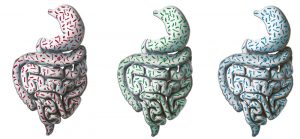Human gut metagenomics, five years of exciting exploration

I defended my PhD in December 2009 and I knew that gut metagenomics will become more and more exiting with such big consortia such as MetaHIT and HMP. Combining with other gut microbiome initiatives within the international human microbiome consortium, they contributed to establish new resources, methods and clinical potential applications using metagenomics datasets.
I made a very rapid review here of huge step articles published during the last five years (I probably forget some of them).
New gut metagenomics resources
The first non redundant human gut microbial gene catalog was released in 2010. It contains 3.3 millions genes obtained from 124 individuals 1. This study confirmed the existence of a phylogenetic core of microbial species and a functional genes core which was observed respectively by my lab thesis2 and by Turnbaugh and colleagues3.
After the two important HMP resources articles with reference genomes from the human microbiome4 and the diversity of all body site of the human microbiome5, the MetaHIT consortium released in 2014 an updated version of the genes catalog including more than 1,200 samples from three continents reaching 10 milions non redundant genes6.
New gut metagenomics methods
Although generating human gut gene catalog is already a huge step of methodological development, other methods have been tested to untangle the complexity of metagenomics dataset. First, unsupervised stratification allowed to discover that there is a limited number of community types called enterotypes7 which could have a long term link with diet8. this discovery was subjected to some debate but a new study9 which used the bayesian inference and multinomial dirichlet developed by Holmes and collegues10 confirmed the original observation.
Using universal markers genes method to study the human gut microbiota, scientists captured in silico twice as species and a practical example has allowed to describe that species richness was lower in ulcerative colitis patients compared to healthy individuals 11. Another method was also developed to call single nucleotide polymorphism from metagenomics data12. Each individual have its own microbial stable genotype : while species abundance could vary, it appears that each individual have their own genotype by species.
The last method published in Nature Biotechnology13 allowed to reconstruct species genomes from metagenomics data. Using co-abundance across individual, this new methodology permitted to identify and to assembly of genomes and genetic elements in complex metagenomic samples without using reference genomes.
New gut metagenomics clinical potential applications
All this resources and new methods was and will be used for further clinical metagenomics associations. Interestingly, the simplest index, the gut microbial genes richness, was correlated with metabolic markers14 and was prognostic to weight loss during low caloric diet over time15. Another study from the ELDERMET consortium showed that gut microbiota from elderly patient is associated with health care management and diet 16. The HMP consortium provided a huge collection of articles in PLoS journal.
I’m wondering with such huge improvement in term of next generation sequencing like the MiniION Oxford Nanopore how those discoveries will find a clinical translation.
References
J Qin et al. MetaHIT consortium. A human gut microbial gene catalogue established by metagenomic sequencing. 2010. Nature 464 (7285), 59-65 ↩
J Tap et al. Towards the human intestinal microbiota phylogenetic core. 2009. Environmental microbiology 11 (10), 2574-2584 ↩
PJ Turnbaugh et al. A core gut microbiome in obese and lean twins. 2009. Nature ↩
Nelson KE et al. A catalog of reference genomes from the human microbiome. Science 2010 May 21 ↩
HMP consortium. Structure, function and diversity of the healthy human microbiome. Nature 2012 Jun 14. ↩
Li et al. MetaHIT consortium. An integrated catalog of reference genes in the human gut microbiome. Nature Biotechnology. 2014 ↩
M Arumugam, J Raes et al. MetaHIT consortium. Enterotypes of the human gut microbiome. 2011. Nature 473 (7346), 174-180 ↩
Wu GD et al. Linking long-term dietary patterns with gut microbial enterotypes. Science 2011 Oct 7 ↩
Ding T and Schloss PD. Dynamics and associations of microbial community types across the human body. Nature. 2014 May 15;509(7500):357-60 ↩
Holmes et al. Dirichlet Multinomial Mixtures: Generative Models for Microbial Metagenomics. PLoS One. 2012. 10.1371/journal.pone.0030126 ↩
Sunagawa et al. Metagenomic species profiling using universal phylogenetic marker genes. Nature Methods.2013 ↩
Schloissnig et al. Genomic variation landscape of the human gut microbiome.. 2013. Nature 493, 45–50. ↩
Nielsen, Almeida et al. MetaHIT consortium. Identification and assembly of genomes and genetic elements in complex metagenomic samples without using reference genomes. Nature Biotechnology. doi:10.1038/nbt.2939 ↩
Le Chatelier et al. MetaHIT consortium. Richness of human gut microbiome correlates with metabolic markers. 2013. Nature. Nature 500 (7464), 541-546 ↩
Cottilard et al. Dietary intervention impact on gut microbial gene richness. Nature; 2013. 500, 585–588. ↩
Claesson MJ et al. Gut microbiota composition correlates with diet and health in the elderly. Nature. 2012 Aug 9;488(7410):178-84. doi: 10.1038/nature11319. ↩